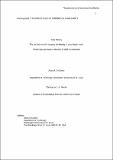Files in this item
The persistence of erroneous familiarity in an epileptic male : Challenging perceptual theories of déjà vu activation
Item metadata
| dc.contributor.author | O'Connor, Akira Robert | |
| dc.contributor.author | Moulin, Christopher J. A. | |
| dc.date.accessioned | 2011-01-05T14:10:01Z | |
| dc.date.available | 2011-01-05T14:10:02Z | |
| dc.date.issued | 2008-11 | |
| dc.identifier | 4846678 | |
| dc.identifier | aced70e9-9ec1-49d5-ba3d-dda2f9eed943 | |
| dc.identifier | 000260738200005 | |
| dc.identifier | 54049124499 | |
| dc.identifier.citation | O'Connor , A R & Moulin , C J A 2008 , ' The persistence of erroneous familiarity in an epileptic male : Challenging perceptual theories of déjà vu activation ' , Brain and Cognition , vol. 68 , no. 2 , pp. 144-147 . https://doi.org/10.1016/j.bandc.2008.03.007 | en |
| dc.identifier.issn | 0278-2626 | |
| dc.identifier.other | ORCID: /0000-0002-7943-5183/work/34028979 | |
| dc.identifier.uri | https://hdl.handle.net/10023/1649 | |
| dc.description.abstract | We report the case of a 39-year-old, temporal lobe epileptic male, MH. Prior to complex partial seizure, experienced up to three times a day, MH often experiences an aura experienced as a persistent sensation of deja vu. Data-driven theories of deja vu formation suggest that partial familiarity for the perceived stimulus is responsible for the sensation. Consequently, diverting attention away from this stimulus should cause the sensation to dissipate. MH, whose sensations of deja vu persist long enough for him to shift his perceptual focus a number of times during the experience, spontaneously reports that these shifts make no difference to the sensation experienced. This novel observation challenges data-driven theories of deja vu formation which have been used to explain the occurrence of deja vu in those with temporal lobe epilepsy and the general population. Clearly, in epilepsy, erratic neuronal firing is the likely contributor, and in this paper we postulate that such brain firing causes higher-order erroneous 'cognitive feelings'. We tentatively extend this account to the general population. Rather than being a reaction to familiar elements in perceptual stimuli, deja vu is likely to be the result of a cognitive feeling borne of the erroneous activation of neural familiarity circuits such as the parahippocampal gyrus, persisting as long as this activation persists. (c) 2008 Elsevier Inc. All rights reserved. | |
| dc.format.extent | 4 | |
| dc.format.extent | 44769 | |
| dc.language.iso | eng | |
| dc.relation.ispartof | Brain and Cognition | en |
| dc.subject | Encephalitis | en |
| dc.subject | Temporal lobe epilepsy | en |
| dc.subject | Seizure | en |
| dc.subject | Aura | en |
| dc.subject | Temporal-lobe epilepsy | en |
| dc.subject | Memory | en |
| dc.subject | Hippocampal | en |
| dc.subject | Experience | en |
| dc.subject | Seizures | en |
| dc.subject | Healthy | en |
| dc.subject | BF Psychology | en |
| dc.subject.lcc | BF | en |
| dc.title | The persistence of erroneous familiarity in an epileptic male : Challenging perceptual theories of déjà vu activation | en |
| dc.type | Journal article | en |
| dc.contributor.institution | University of St Andrews. School of Psychology and Neuroscience | en |
| dc.identifier.doi | 10.1016/j.bandc.2008.03.007 | |
| dc.description.status | Peer reviewed | en |
This item appears in the following Collection(s)
Items in the St Andrews Research Repository are protected by copyright, with all rights reserved, unless otherwise indicated.

